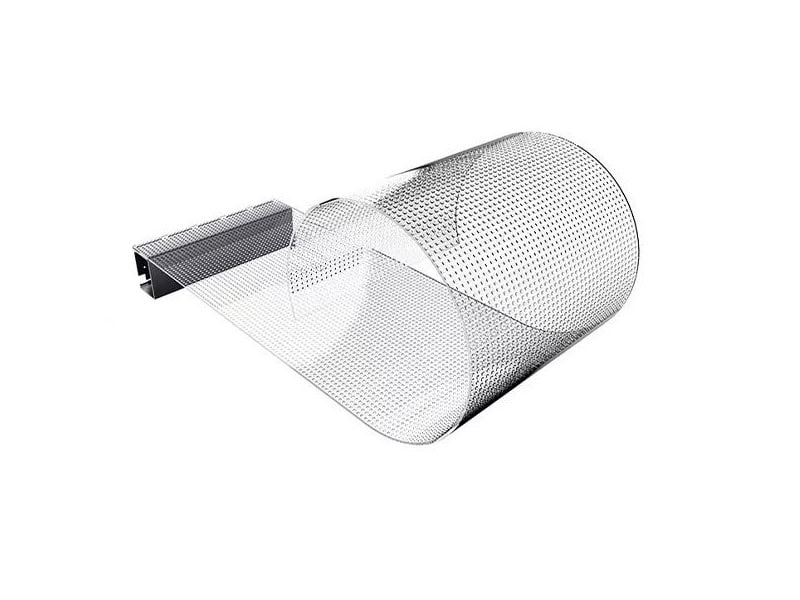What is transparent led screen?
A transparent LED screen is a new type of See-through LED display,has a 70%-95% transmittance rate. The thinnest panel is only 3mm. It consists of transparent LED modules mounted on a transparent substrate like glass or acrylic. These modules contain individual LEDs arranged in a grid pattern to form the display
The key feature of transparent LED displays is their high transparency, which allows visibility from both sides of the screen. This is achieved through micro-innovations in LED strip screens, improvements in chip manufacturing, LED packaging, and control systems. The hollow structure design minimizes obstruction to the line of sight, enhancing the perspective effect and seamless integration with the surrounding environment
How many kinds transparent led screen?
- Classification by production process
Transparent led mesh screen
Transparent LED mesh screens consist of interwoven LED strands, creating a semi-transparent display. They are lightweight and flexible, making them suitable for large-scale installations at events, concerts, or architectural features. The mesh design allows for high transparency (over 75%), enabling viewers to see through the screen while still displaying vibrant content. These screens are ideal for applications where visibility and aesthetic integration are essential, such as in shopping malls and building facades
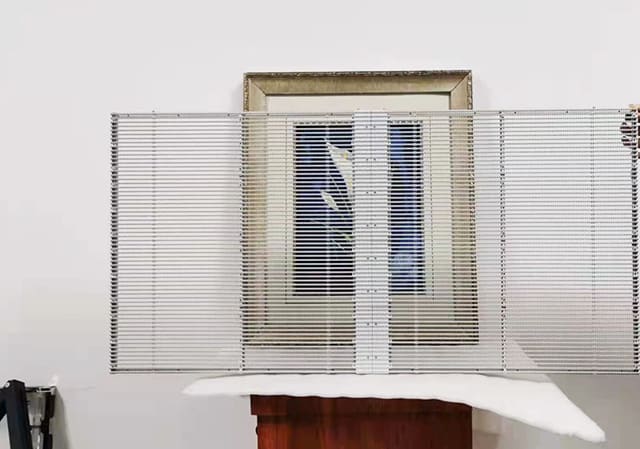
Key Features of Transparent Led Mesh Screen
- High transparency (60%-90% light transmission)
- Suitable for large-scale outdoor applications like architectural facades
- Lightweight and flexible for installation
- Wind-resistant due to the mesh structure
- High brightness, making it suitable for daylight viewing
Transparent Led Mesh Screen Applications
Commonly used for indoor and outdoor advertising, glass curtain walls, and large-scale commercial buildings.
Flexible Transparent led film screen
Transparent LED film is a adhesive thin, flexible material that can be applied directly to existing glass surfaces, transforming them into transparent displays. This type of screen offers high transparency (up to 90%) and is often used in retail environments, hospitality settings, and transportation hubs. The film is easy to install and maintain, making it a cost-effective solution for retrofitting traditional windows without major structural changes

Transparent Led Film Key Features:
- Ultra-thin and lightweight
- Flexible, can be applied to flat or curved glass surfaces
- High transparency (up to 95% light transmission)
- Easy to install on existing glass without requiring structural changes
- Can be cut and customized to different sizes and shapes
Transparent Led Film Application
Used for glass windows in retail stores, exhibition displays, office buildings, and glass facades.
Glass Led Screen
Glass LED screens integrate LED technology into glass panels, allowing for dynamic digital displays while maintaining the aesthetic appeal of glass. These screens can be mounted on windows or architectural elements, providing a seamless blend of functionality and design. They are commonly used in retail window LED display, museums, and corporate environments where both visibility and visual impact are critical.
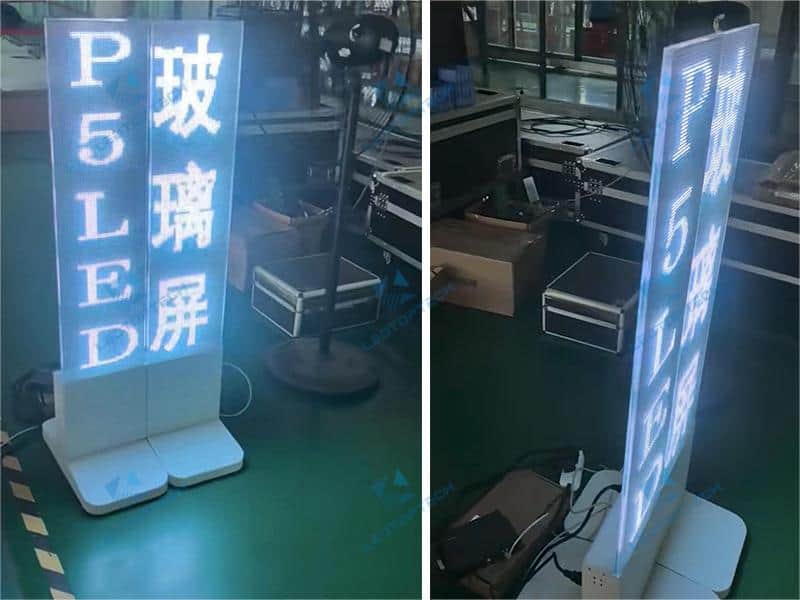
Glass Led Display Key Features:
- Built directly into glass panels
- Offers high transparency and structural strength
- Seamlessly integrated into building design
- High brightness and weather resistance for both indoor and outdoor use
- Permanent, durable, and strong for architectural applications
Glass Led Display Application
Typically used in high-end architectural projects, glass curtain walls, and building facades for permanent installations.
Holographic Film Screen
Holographic film screens utilize advanced projection technology to create three-dimensional images that appear to float in mid-air. This type of screen is often used for artistic installations, advertising, and interactive displays. Holographic film can enhance the viewer’s experience by providing an illusion of depth and movement without obstructing the view behind the display
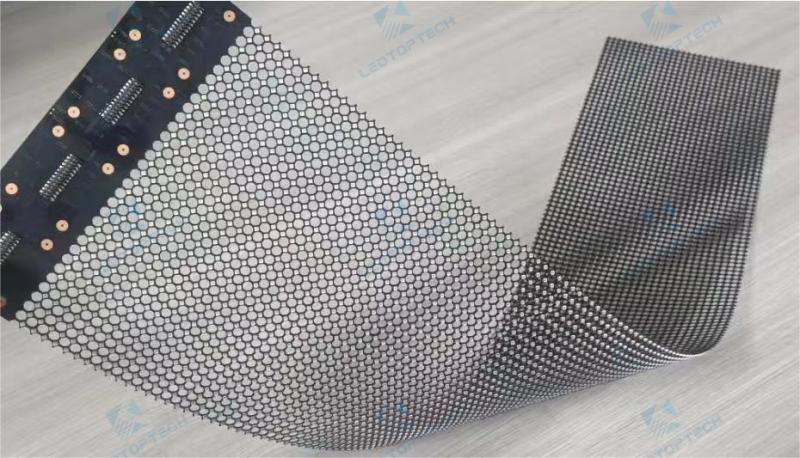
Holograohic Film Screen Key Features:
- Can display holographic 3D images
- Highly transparent and can be applied to existing glass
- Creates an illusion of images floating in the air
- High clarity and contrast in both low and high light environments
Holograohic led Film Screen Application
Used in museums, high-end retail stores, exhibitions, and events where visual impact and 3D effects are important.
- Classification by Usage
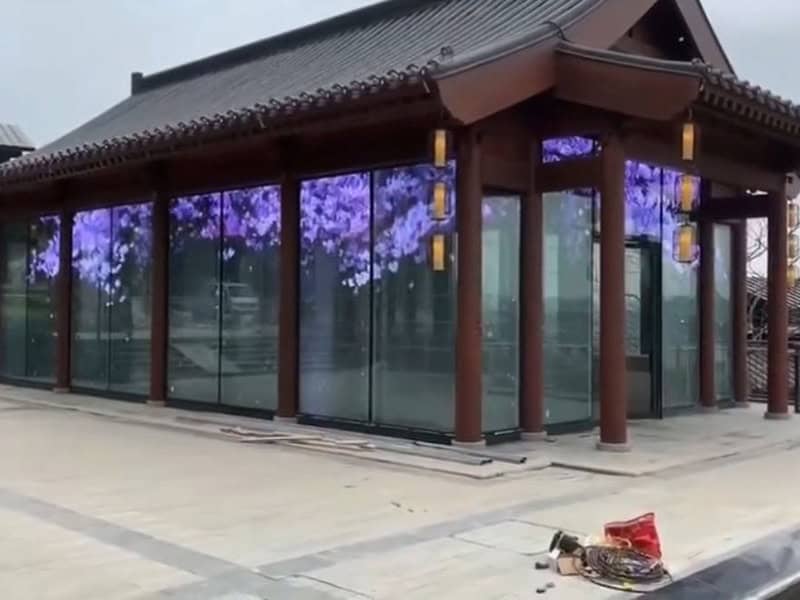
Advertising transparent led display
A advertising transparent LED display is a permanent, high-transparency digital signage solution designed for storefronts, glass walls, and building facades. It offers bright, vivid content visibility while maintaining up to 90% transparency, ensuring the view behind the screen is not obstructed. Ideal for long-term outdoor or indoor advertising, it combines aesthetic appeal with effective messaging.
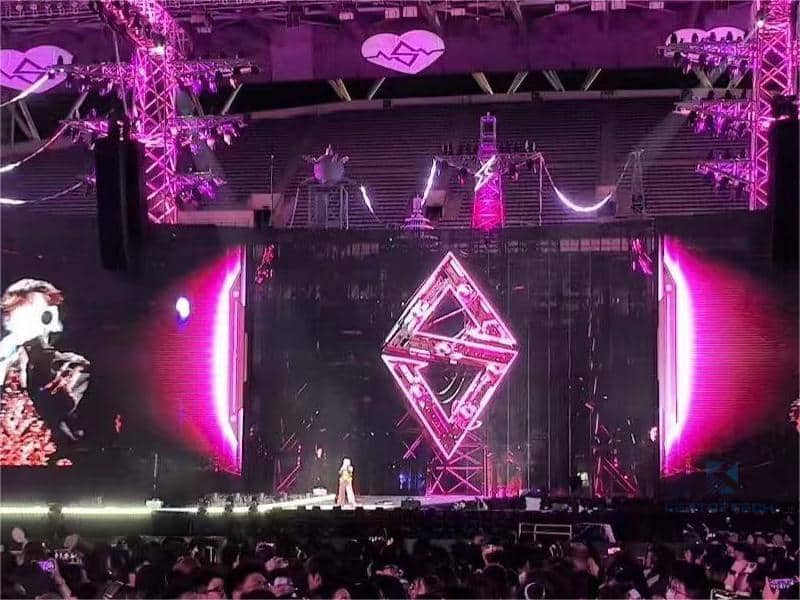
Rental transparent led screen
A rental transparent LED screen is a lightweight, portable display solution designed for temporary events such as exhibitions, concerts, and trade shows. It offers high transparency and easy assembly, allowing for quick setup and takedown without obstructing views. Ideal for creating stunning visual effects while maintaining flexibility for short-term installations.
How to Choose the Best Transparent Led Screen Option?
Choosing the best kind of transparent LED screen depends on several factors, including the application, environment, budget, and desired visual effects. Here’s a step-by-step guide to help you make the best choice:
1. Main Purpose of the Screen
Start by identifying the main purpose of your transparent LED billboard:
- Advertising and Branding: For store windows, retail displays, and promotional content.
- Architectural Integration: For building facades, glass walls, and permanent installations.
- Special Effects and Immersive Experiences: For exhibitions, museums, or product launches where 3D effects or holographic visuals are needed.
2. Consider the Installation Location
Where the screen will be installed has a significant impact on the type of screen you should choose.
- Outdoor Use: If the screen will be installed outdoors, consider transparent LED mesh screens or LED glass display screens. These are designed to withstand environmental factors such as wind, rain, and direct sunlight. Mesh screens, for instance, have strong wind resistance and high brightness for daylight visibility.
- Indoor Use: For indoor installations like shopping malls, office buildings, or exhibition halls, a transparent LED film or holographic film screen could be the best option. These screens are lightweight, easy to install, and ideal for environments that don’t require weather resistance.
3. Evaluate Transparency Requirements
Different transparent LED screens offer varying levels of transparency, so it’s important to decide how transparent the display needs to be:
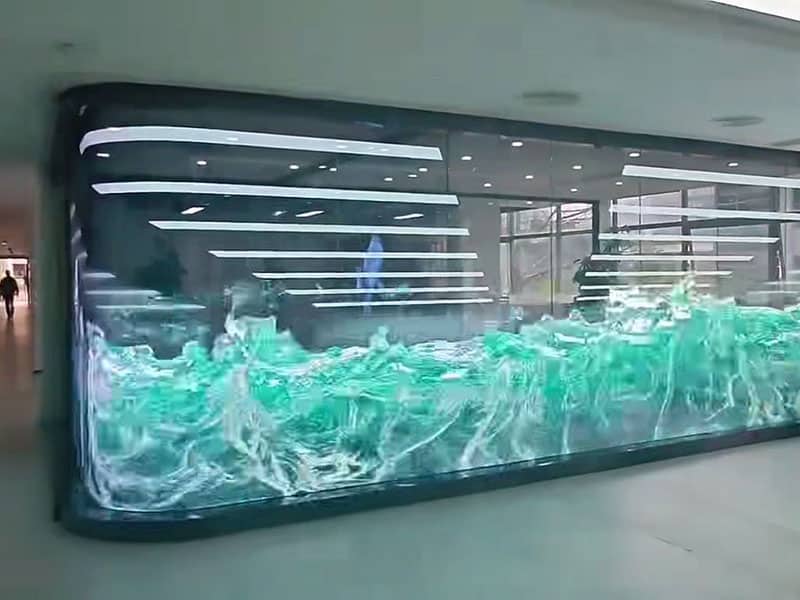
- High Transparency (90% and above): If maintaining clear visibility through the glass is critical (e.g., storefronts or building facades), transparent LED film is a top choice. It offers excellent transparency and can be applied to existing glass without obstructing views.
- Moderate Transparency (60%-90%): For installations where some opacity is acceptable (e.g., large architectural displays), transparent LED mesh display or glass LED screens are suitable. Mesh screens offer moderate transparency with better durability for outdoor use.
4. Brightness Requirements
The brightness of the screen determines its visibility in different lighting conditions:
- High Brightness: For outdoor use or environments with a lot of natural light, choose a screen with high brightness like high brightness transparent LED mesh. These are designed for clear visibility even under direct sunlight.
- Medium Brightness: For indoor use or controlled lighting environments, transparent LED mesh , LED film and holographic screens can provide sufficient brightness while maintaining a sleek and modern look.
5. Installation Flexibility
The complexity of the installation is another key consideration:
- Retrofitting Existing Glass: If you’re adding the screen to existing glass surfaces, transparent LED film and mesh are the easiest option. It’s flexible, ultra-thin, and can be directly applied like a sticker, making it perfect for glass windows or glass walls.
- Permanent Structural Integration: If the screen will be integrated into the building itself (e.g., as part of a glass curtain wall or facade), glass LED screens are a more durable and integrated solution. They are built directly into the glass panels during construction.
- Temporary or Semi-Permanent Installations: For temporary installations (e.g., events, exhibitions, or stage backgrounds), portable holographic film poster or transparent LED mesh could be ideal due to their relatively easy setup and removal.
6. Visual Impact and Effects
Consider the type of visual effect you want to achieve:
- 3D Effects and Holograms: For eye-catching, immersive experiences, a holographic film screen is the best choice. It creates a 3D-like illusion, ideal for exhibitions, high-end product launches, and events where impact matters.
- Standard Digital Displays: If your goal is to display clear, bright digital content like advertisements, promotions, or branding messages, a transparent LED mesh screen or LED film will provide a strong digital presence while maintaining transparency.
7. Budget Considerations
Transparent LED screens come in a range of prices depending on the type of technology and size:
- Higher Budget: Glass LED screens,Transparent LED film and holographic film screens are offering durability and good visibility at a reasonable price for outdoor advertising or large indoor installations.
- Lower Budget: Transparent LED mesh are generally more affordable and flexible, making them a good option for indoor and outdoor displays, large building facade installations, or when retrofitting onto existing glass.
8. Customization and Size
- Customizable: If you need a screen that can be cut to custom shapes and sizes (for example, fitting uniquely shaped windows or glass surfaces), transparent LED film offers the most flexibility.
- Large-Scale Installations: For large displays like full glass facades or expansive advertising spaces, transparent LED mesh screens or glass LED screens are better suited due to their scalability and robust construction.
How Much Does A Transparent Led Screen?
The cost of a transparent LED screen typically ranges from $200 to $2,500 per square meter, depending on various factors such as model, pixel pitch, and customization requirements.
For example, Indoor transparent LED mesh displays p3.9-7.8 price is usd250-usd450 per square meter. If Screen size is 6x3m, the total cost of screen and control system, package will be usd5000 -usd9000.
Factors Influencing Cost
Pixel Pitch: Smaller pixel pitches (higher resolution) increase the cost due to more LED beads being required.
Size and Customization: Larger screens and those requiring unique designs or configurations will incur higher costs due to additional materials and engineering efforts.
Installation Requirements: The complexity of the installation can also affect the overall price, especially for custom or curved installations.
Overall, while the upfront investment for transparent LED screens can be significant, their unique visual capabilities and applications often justify the cost for businesses seeking innovative display solutions. By the way, purchasing from manufacturer will save cost for you. Contact professional engineer to get newly price to calculate cost.
Things to Consider When Buying A Transparent Led Screen
When purchasing a transparent LED display, several key factors should be considered to ensure you select the right product for your needs. Here are the most important aspects to keep in mind:
1. Location and Environment
Ambient Lighting: Assess the lighting conditions where the screen will be installed. High ambient light areas may require displays with higher brightness levels.
Environmental Conditions: Consider temperature, humidity, and exposure to elements (for outdoor installations) to ensure the screen can withstand these conditions.
2. Size and Resolution
Determine the appropriate size based on available space and viewing distance. Larger screens are better for distant viewing, while higher resolutions are needed for closer distances to ensure clarity.
3. Pixel Pitch
The pixel pitch (distance between individual LEDs) affects image quality. A smaller pixel pitch results in higher resolution and better image clarity, which is crucial for detailed content.
4. Mounting Options
Transparent LED displays can be installed in various ways: adhesive, wall-mounted, hanging, or floor-supported. Choose an installation method that suits your space and design requirements, ensuring that the mounting structure is stable and secure.
5. Connectivity and Control System
Ensure compatibility with existing infrastructure regarding connectivity options (HDMI, DVI, Ethernet, wifi, 5g/4g) and select a user-friendly control system for content management.
6. Content Management
Plan how content will be created, scheduled, and updated. Ensure that the display is compatible with your chosen content management software.
7. Maintenance and Support
Consider the availability of technical support, warranty coverage, and spare parts. Understand the maintenance requirements to ensure longevity and optimal performance of the display.
8. Power Requirements
Verify that adequate power supply and electrical infrastructure are available at the installation site to meet the screen’s power needs.
9. Customization Options
If you have specific design requirements (like curved installations or unique shapes), ensure that the manufacturer can accommodate these needs without incurring excessive costs.
10. Budget Considerations
Transparent video wall can vary significantly in price depending on size, resolution, and customization options. Establish a budget that includes not just the initial purchase but also installation and ongoing maintenance costs.
By carefully evaluating these factors, you can make an informed decision when buying a transparent LED wall that meets your specific needs and enhances your visual communication efforts.
How Do I Choose The Right Mounting Structure For My Transparent LED Screen?
To choose the right mounting structure for your transparent LED screen, consider the installation environment, weight capacity, and mounting methods. Selecting an appropriate structure is crucial for ensuring stability, safety, and optimal performance of the display.
1.Installation Environment: Assess whether the installation is indoors or outdoors. Outdoor installations may require sturdier structures to withstand environmental factors like wind and rain. Additionally, consider ambient lighting conditions, as they can affect visibility.
2. Weight and Size of the Screen: Transparent LED screens typically weigh between 3 to 8 kg per square meter. Ensure that the mounting structure can adequately support this weight without sagging or shifting over time.
3. Mounting Methods:
- Floor-Supported Installation: Suitable for exhibition spaces, this method relies on a steel frame to support larger screens without area restrictions.
- Wall-Mounted Installation: Ideal for fixed installations on walls; ensure that the wall can bear the weight and that proper anchors are used.
- Hanging Installation: This method allows flexibility in design and is often used in large venues. It requires secure hanging structures like beams or hooks.
- Adhesive Mounting: For flexible transparent LED films, adhering directly to glass surfaces is an option that maintains transparency and does not obstruct light.
4. Structural Integrity: Consult with structural engineers or professional installers to ensure that the chosen mounting structure complies with local building codes and can withstand external loads.
5. Power and Connectivity: Ensure that the mounting structure allows easy access to power sources and connectivity options (HDMI, DVI, Ethernet, wifi, 5g/4g) for easier installation and maintenance.
6. Safety Precautions: Implement safety measures during installation, including using appropriate tools and protective gear. Ensure all electrical connections are secure and comply with safety standards.
7. Maintenance Access: Design the mounting structure to allow easy access for maintenance tasks such as cleaning or replacing components, which is crucial for maintaining image quality and screen longevity.
By carefully evaluating these factors, you can select a suitable mounting structure that enhances both the functionality and aesthetic appeal of your transparent LED screen while ensuring safety and ease of use.
Conclusion
After understanding the key factors involved in choosing the right transparent LED screen, the next step is finding a reliable manufacturer to partner with. Ledtop Technology is a leading transparent LED display factory, renowned for its strong technical capabilities and proven track record. With high-quality products and tailored solutions, they are a trusted partner for businesses seeking impactful and durable transparent LED display solutions.
